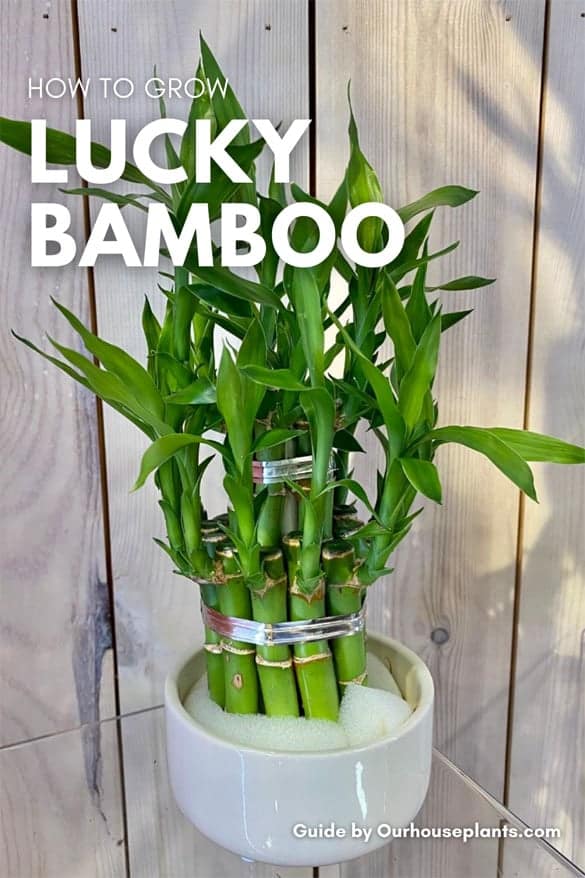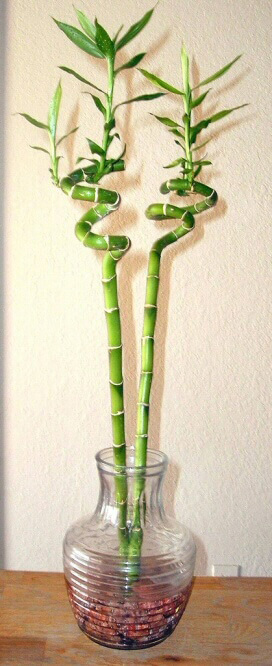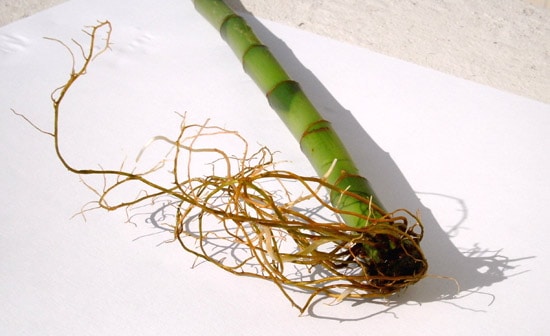Lucky Bamboo is actually Dracaena sanderiana (also called Dracaena braunii) which normally adopts the common name Lucky Bamboo when sold.
There isn't really a well known reason for how this common name came about, although Dracaena sanderiana grows easily in water and the canes of the plant have a similar appearance to real bamboo stalks, it has no true connection with Japanese culture.

Several canes growing together to produce a bushy and stylish display.
Lucky Bamboo is not actually bamboo and may or may not actually be lucky! Instead it's generally accepted that the name was created as a way of marketing a quite standard and seldom grown houseplant.
The truth of the matter is that Dracaena sanderiana when grown "normally" is quite boring, the leaves tend to be spaced out and although they can have pretty markings they're quite small and often unremarkable.
Of course like all houseplants there will be fans, it just follows that finding it in its standard form is difficult. Instead you will normally find these plants grown in water in very unique and fashionable pots and display stands, as well as the canes being interesting themselves, sometimes curly or having bends to create unusual shapes.
All of this together creates an eye catching plant which is the selling point and that is what makes a Lucky Bamboo plant attractive and an idea gift or house guest.
As for the luck element...
...Well you'll have to buy one and test that claim for yourself! Even if it doesn't help you win the lottery this week, all houseplants have multiple benefits for human health so in that respect it's certainly far from being a pointless or useless indoor plant to have in your home.
If you fall for it's quirky appearance and decide to buy one for yourself or have been gifted one, the care requirements for your Lucky bamboo plant to keep it healthy and looking good are detailed below.

Lucky bamboo spiral houseplant - photo by Toby Lee Spiegel

Hi, I'm Tom!
If you're like me and enjoy the challenge of growing houseplants and getting them to thrive, then Ourhouseplants can help. This website shares my knowledge and years of growing plants and provides (hopefully) helpful advice on properly caring for your indoor plant friends.
Like most plants belonging to the Dracaena family, they dislike harsh sunlight and no light locations. Good growth will come from light shade. If there is too much or not enough light the leaves suffer (see Lucky Bamboo Problems section if you think you have light related issues).
For good growth, light shade is best for these houseplants
If growing Lucky Bamboo in water, then the roots should be submerged at all times and you will need to change the water every couple of weeks to prevent it going stagnate. Ensure you don't use tap water over a continuous period and instead try to use either bottled mineral water, a home water filter or freshly collected rain water when possible and feasible to do so.
This is because most of what comes out of the tap in the developed world is fluoridated (to prevent human tooth decay) and chlorinated (to purify it for use as drinking water) but this can cause damage to the plants leaves and general growth overtime.
If you're growing it in soil you should water as you would other Dracaena related plants. Which is to aim for moist conditions during the growing season and reduce the amount given in Winter.
Average home humidity is fine for your plant.
There is no need to feed Lucky Bamboo if it's growing in water. If you later decide to transfer it to a normal compost mix (or that's how you are growing it anyway), feed a few times a year at normal strength, once in Spring and again in Summer.
Good growth will result from temperatures between 16°C - 24°C / 60°F - 75°F. Don't try and grow your plant at temperatures lower than 10°C / 50°F.
You don't have to repot Lucky Bamboo unless it's growing in a normal pot containing soil, if this is the case you will probably need to do it every two or three years.

Lucky bamboo often have orange roots - photo by Bernard Ladenthin
The roots in water containers can get quite long and extensive, so by all means transplant them to a large water container if you want but you don't have to. Although be sure to replace the water from time to time to keep it fresh.
Mature cane cuttings take quite easily in water. Once rooted, pot up in compost or carry on growing in the water container.
Soft tip cuttings (i.e. new leaf growth) are usually less successful. Putting them in water often causes them to rot and rooting can be difficult if you go straight for the soil in a pot route. Generally speaking it's far simpler and less stressful to just go out and buy a new plant.
The Lucky Bamboo plant normally grows quite slowly.
This is difficult to answer because this houseplant can be grown in different ways and comes in different shapes and sizes. As a guide only, the plant you buy / receive could almost double in height after several years of good treatment.
Dracaena varieties grown as houseplants, including Lucky Bamboo rarely flower indoors so don't expect any.
Lucky Bamboo is sometimes labeled as Phyllostachys aurea which isn't poisonous to people, cats or dogs. However the most commonly grown Lucky Bamboo is Dracaena Sanderiana (shown in all the pictures on this page) and most Dracaena have a mild level of toxicity in the leaves and stems which present mild symptoms when ingested.
If you've decided to grow your plant in water permanently then it should still last a few years in your home or workplace, providing you change the water every couple of weeks.
Leaves with brown spots
Usually caused by underwatering in pot grown plants. Try to keep the soil moist. If they're more "blotches" than spots, it's caused by overwatering.
Lucky Bamboo leaves have brown tips
In exclusively water grown plants, it's usually caused by a build up of fluoride and chlorine. Check the watering tips above to avoid this. This is less likely in pot grown plants because the negative effects of fluoride and chlorine are negated by the soil itself, but it's still something to look out for over a long period.
Lucky Bamboo leaves have brown tips AND yellow edges
This tends to be caused by dry air or cold draughts.
Pale leaves
Either too much light which results in bleached dry leaves or sections. If the entire leaf is pale then it's probably caused by not providing enough light or exposure to very cold temperatures.
Yellow lower leaves / leaf drop
If this is happening slowly this is normal and not a sign your Lucky Bamboo plant is dying. All Dracaenas are False Palms with a crown of leaves sitting at the top of their stems, new growth forms at the very tips of these stems, and the older leaves at the bottom of the crown will eventually yellow and fall. This is also really common in the well known Dragon Tree.
Pruning Lucky Bamboo?
The plant needs to look "balanced" for it to remain somewhat attractive. If you want to prune or reshape Lucky Bamboo then snip off the shoots you no longer want. Think carefully, take your time and pick which leaves to remove cautiously as you won't be able to put them back if you make a mistake.
Credit for Tall Lucky Bamboo in vase - Article / Gallery - Toby Lee Spiegel
Credit for Lucky Bamboo roots - Article / Gallery - Bernard Ladenthin
Credit for Lucky Bamboo in black pot - Gallery - Champlax
Credit for Dark Green Lucky Bamboo photo - Gallery - Lilkittay
Credit for Lucky Bamboo roots - Gallery - Life @ 35 (mm)
Credit for close up photo of new Lucky Bamboo shoot - Gallery - Lilkittay